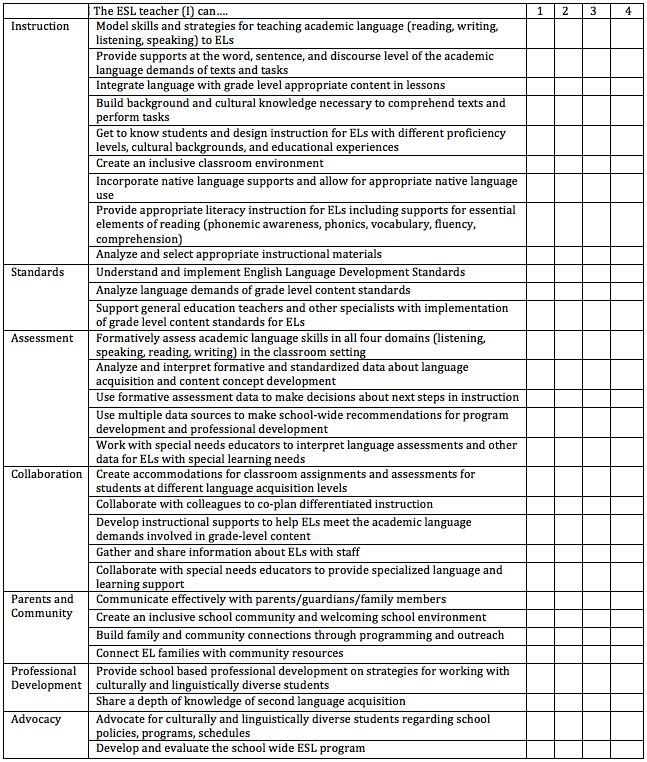Table of Contents
Start With An ESL Self Assessment
By Beth Skelton
 In the past few years, I have had the opportunity to provide professional development for many English as a Second Language (ESL) teachers. These specialists are now expected to take on more and more roles and be skilled in areas well beyond the classroom. As one principal told me when he began hiring for an ESL teacher, “The new ESL teacher can no longer just teach small groups of students in a pullout classroom. I need someone who can reach out to the community, collaborate with the rest of the staff, and provide on-going professional development.” Another school director in a similar situation told me, “ESL teachers are a dime a dozen, but I need an ESL leader. They are few and far between.” The seven scenarios in this article provide strategies for how school leaders can capitalize on ESL specialists’ strengths and transform these educators into school leaders.
In the past few years, I have had the opportunity to provide professional development for many English as a Second Language (ESL) teachers. These specialists are now expected to take on more and more roles and be skilled in areas well beyond the classroom. As one principal told me when he began hiring for an ESL teacher, “The new ESL teacher can no longer just teach small groups of students in a pullout classroom. I need someone who can reach out to the community, collaborate with the rest of the staff, and provide on-going professional development.” Another school director in a similar situation told me, “ESL teachers are a dime a dozen, but I need an ESL leader. They are few and far between.” The seven scenarios in this article provide strategies for how school leaders can capitalize on ESL specialists’ strengths and transform these educators into school leaders.
If ESL teachers understand their abilities and are interested in developing their skills in other areas, they can become the leaders that many principals desperately need. I have worked with ESL teachers who are brilliant with newcomers and insightful data analysts. Others work well with their colleagues and enjoy collaboration or know how to connect with parents and community resources. The following self-assessment can help ESL teachers and school leaders determine areas of strength, develop programs that build on those strengths, and focus professional development efforts on needed areas of growth. After completing the survey, read through the scenarios that show how some schools have harnessed their ESL teacher’s strengths in different areas and developed a transformative leader.
ESL Teacher Self-Assessment
Mark the number next to each statement in the table below that best describes your ability in that skill area.
1= I’m not sure how to do this yet.
2= I understand the concept and I can do this with support from a colleague.
3= I can consistently and competently do this independently and successfully
4= In addition to #3, I can teach others this skill
 Scenario 1: Instruction
Scenario 1: Instruction
When it comes to instruction, ESL teachers are often expected to be master teachers. I had the opportunity to work with Jane, a third-grade teacher in a rural, Title 1 school, for several years while she completed her ESL endorsement. She consistently made her lessons comprehensible with realia, labeled diagrams, and visual word walls. She was a strong  team leader who supported her colleagues with lesson planning and instructional strategies. When the ESL teacher retired, the principal recruited Jane to lead the ESL program that supported over sixty percent of the student body. He recognized Jane’s strengths as an instructional leader and asked me to teach her to be an instructional coach. Over the past two years, Jane has become a skilled coach helping her colleagues at all grade levels to implement strategies for working with ELs. When the ESL teacher becomes an instructional leader, she can impact all students and teachers.
team leader who supported her colleagues with lesson planning and instructional strategies. When the ESL teacher retired, the principal recruited Jane to lead the ESL program that supported over sixty percent of the student body. He recognized Jane’s strengths as an instructional leader and asked me to teach her to be an instructional coach. Over the past two years, Jane has become a skilled coach helping her colleagues at all grade levels to implement strategies for working with ELs. When the ESL teacher becomes an instructional leader, she can impact all students and teachers.
Scenario 2: Standards
ESL teachers are usually required to implement the English Language Development standards as well as support each grade level’s content standards. At a highly impacted middle school, the principal asked me how she could best leverage the ESL teacher’s background as a certified science teacher. We created a flexible schedule so that Joe, the ESL teacher, and the science teachers had time each week to analyze the language demands of the content standards. After reviewing the vocabulary, grammatical structures, and discourse level elements inherent in the science standard for the upcoming unit, Joe offered his colleagues ideas for scaffolds and supports that helped the ELs meet the language demands of the standard. When ESL specialists help their colleagues develop the language embedded in the content standards, ELs will be more successful in grade level content classes.
Scenario 3: Assessment
 Formative, summative, and standardized assessments can all contribute information that help ESL teachers make effective instructional and programmatic decisions. For years, Lisa, a secondary ESL specialist at a middle school with high numbers of newcomers, maintained efficient longitudinal language acquisition data on her students and reviewed the data for trends regularly, but she had no formal position in the school’s leadership or data team. Unfortunately, much of her information was not shared with her colleagues. During one meeting with the school’s leadership team, I asked Lisa to share her data about a student being considered for special education. The principal quickly realized that Lisa’s careful documentation and detailed analyses were essential for decision making. Lisa is now included on the school’s data team and all ELs and teachers benefit from her insights. ESL teachers who are skilled at data analysis can help school leaders and their colleagues meet the special needs of ELs.
Formative, summative, and standardized assessments can all contribute information that help ESL teachers make effective instructional and programmatic decisions. For years, Lisa, a secondary ESL specialist at a middle school with high numbers of newcomers, maintained efficient longitudinal language acquisition data on her students and reviewed the data for trends regularly, but she had no formal position in the school’s leadership or data team. Unfortunately, much of her information was not shared with her colleagues. During one meeting with the school’s leadership team, I asked Lisa to share her data about a student being considered for special education. The principal quickly realized that Lisa’s careful documentation and detailed analyses were essential for decision making. Lisa is now included on the school’s data team and all ELs and teachers benefit from her insights. ESL teachers who are skilled at data analysis can help school leaders and their colleagues meet the special needs of ELs.
Scenario 4: Collaboration
Some ESL teachers have a gift for connecting with colleagues and working collaboratively in and out of the classroom. A principal in an elementary school with thirty percent ELs decided to leverage the ESL teacher’s collaborative skills by formalizing co-teaching partnerships. I worked closely with the ESL teacher, Kathy, and the principal to cluster beginning level ELs into one grade level classroom. Then we created a school wide schedule that enabled Kathy to co-plan and co-teach writing classes in each grade level. The results on standardized writing assessments for the co-taught classes for all students and especially the ELs was so impressive that the principal expanded the co-teaching model in the following school year. When ESL teachers share strategies, supports, and scaffolding ideas with colleagues, all students benefit from the collaboration.
Scenario 5: Parents and Community
Working with parents and connecting with community resources that support the families of English Language Learners is an important part of many ESL teachers’ job description. One elementary principal recognized that her ESL teacher, Kevin, was an asset to the entire community since he was born in the area, spoke the dominant language Spanish, and understood the culture of this school population. I supported Kevin in launching an adult English class for the students’ parents two mornings a week.  Later we developed a parent-child reading program on those mornings. After participating in the morning language classes, native Spanish speaking parents felt more comfortable at school and attended school functions at a higher rate. When ESL specialists offer adult language classes, conduct home visits, and provide information about community resources, parent engagement increases and the entire school community benefits.
Later we developed a parent-child reading program on those mornings. After participating in the morning language classes, native Spanish speaking parents felt more comfortable at school and attended school functions at a higher rate. When ESL specialists offer adult language classes, conduct home visits, and provide information about community resources, parent engagement increases and the entire school community benefits.
Scenario 6: Professional Development
Being a teacher for K-12 students and teaching teachers are two distinct skill sets. Some ESL teachers are uncomfortable about providing workshops or formal professional development sessions for their colleagues, but many districts expect the ESL specialist to provide some kind of on-going professional development. One district I worked with offered “Train the Trainer” workshops for ESL teachers who were interested in providing professional development (PD). Teachers who participated in these sessions had the opportunity to practice their workshop and receive feedback before they presented to their colleagues. Several principals in that district made time for their ESL teachers to provide mini-ESL PD sessions at faculty meetings and scheduled monthly after school workshops as well. When the entire staff understands language acquisition and best practices for working with ELs, all teachers will become language teachers.
Scenario 7: Advocacy
 Advocating for ELs comes naturally to many ESL specialists, but others feel intimidated or overwhelmed with the prospect of speaking out to school and district leaders about the needs of their students. In one district with low graduation rates for ELs, the high school ESL specialist, Sherry, first addressed the issue within her circle of influence. With support from the administration, she created a peer-tutoring program and worked closely with the school’s guidance counselor to create schedules for the ELs that would put them on the path to graduation. In just two years, Sherry’s efforts paid off—the EL graduation rate increased significantly. She now serves on a district-wide committee dedicated to ensuring that ELs graduate. ESL teachers who advocate for their students can make a significant, positive impact on their education and futures.
Advocating for ELs comes naturally to many ESL specialists, but others feel intimidated or overwhelmed with the prospect of speaking out to school and district leaders about the needs of their students. In one district with low graduation rates for ELs, the high school ESL specialist, Sherry, first addressed the issue within her circle of influence. With support from the administration, she created a peer-tutoring program and worked closely with the school’s guidance counselor to create schedules for the ELs that would put them on the path to graduation. In just two years, Sherry’s efforts paid off—the EL graduation rate increased significantly. She now serves on a district-wide committee dedicated to ensuring that ELs graduate. ESL teachers who advocate for their students can make a significant, positive impact on their education and futures.
ESL specialists serve a critical role in the education of ELs. These seven scenarios illustrate some ways school leaders can promote the ESL teacher’s strengths so that they can transform into school-wide educational leaders.
Related Reading:
Fenner, Diane Staehr. Advocating for English learners. Corwin/Tesol International Association, 2014.
Gottlieb, Margo, and Mariana Castro. Language power: key uses for accessing content. Thousand Oaks, CA: Corwin, 2017.
Honigsfeld, Andrea, and Maria G. Dove. Collaboration and co-teaching for English learners: a leaders guide. Thousand Oaks: Corwin, a Sage Company, 2015.
MacDonald, Rita, Timothy Boals, Mariana Castro, H. Gary Cook, Todd Lundberg, and Paula A. White. Formative language assessment for English learners: a four-step process. Portsmouth, NH: Heinemann Publishing, 2015.
Rojas, Virginia Pauline. Strategies for success with English language learners. Alexandria, VA: Association for Supervision & Curriculum Development, 2007.
Author
Further Reading
- The Spokesman-Review – Gonzaga language program for ESL students grows in popularity
- The Grand Island Independent – Focusing on fluency: Teachers go the extra mile
- Oakland Press – Oakland University English Second Language majors help young students



 Scenario 1: Instruction
Scenario 1: Instruction